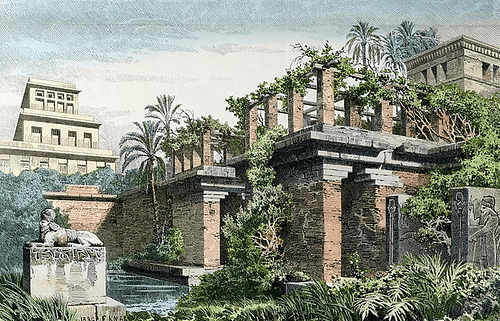

The Hanging Gardens of Babylon are a very strange miracle and quite a mysterious wonder. These gardens were one of the Seven Wonders of the Ancient World but the location of this wonder has not been established, yet. No Babylonian records portraying them have been found. We don’t even know the demolition date of this marvel. Maybe it was a Greek fantasy. It was said that, these gardens were built in ancient city named Babylon, at present its location has been narrowed down to the Hillah, Babil Province, in Iraq. However, there is no existence of these Hanging Gardens. The lack of evidence supporting its existence has not deterred avid scholars from studying and debating issues surrounding it. Because of the lack of proper documentation of The Hanging Gardens of Babylon, it is thought that, these may have been simply a figment of ancient impulses, a story to be told in the archives of old myth and history.
Berossus, a Chaldaean priest and also a writer of ancient Babylon who lived in the late 4th century BC, first described the Hanging Gardens in his book named Babyloniaca which was written around 280 BC and was later quoted by Josephus. Berossus described the garden and also the founder, The Great Babylonian King named Nebuchadnezzar II. Many Greek historians also described these hanging gardens by citing from Berossus’ works.
According to the various ancient sources, Nebuchadnezzar built The Hanging Gardens for his wife Amytis around 600 BC. His wife Amytis was homesick for her lush, sloping & mountainous home and felt discouraged living in the flat, dry and dusty land which was Babylon. So the garden was built to give her some feelings of her homeland.
Actually the hanging garden did not hang at all. One of the Greek geographers named Strabo wrote about these hanging gardens. In his writing he described a, “…simulated mountain resting upon square formed pillars.” It is believed that all those columns were hollow and filled with soil which was trees of the largest size to be planted. The pillars or columns and terraces were built with baked brick and asphalt.
In a flat, dry and dusty land like Babylon, rain was rare. So the main problem was irrigation to sustain those gardens. The main source of water was the nearby Euphrates River and the water had to be lifted from the river to the top of the terrace to water those gardens at each level. The task was so much tougher with the lack of modern pump technology in the 5th century BC. So the designer’s solution to move the water from river was to use the “Chain Pump”.
Recent excavations have been done by archaeologists on the bank of the Euphrates River and they have found some substantial 82 feet-thick walls which could have been part of the Hanging Gardens of Babylon.